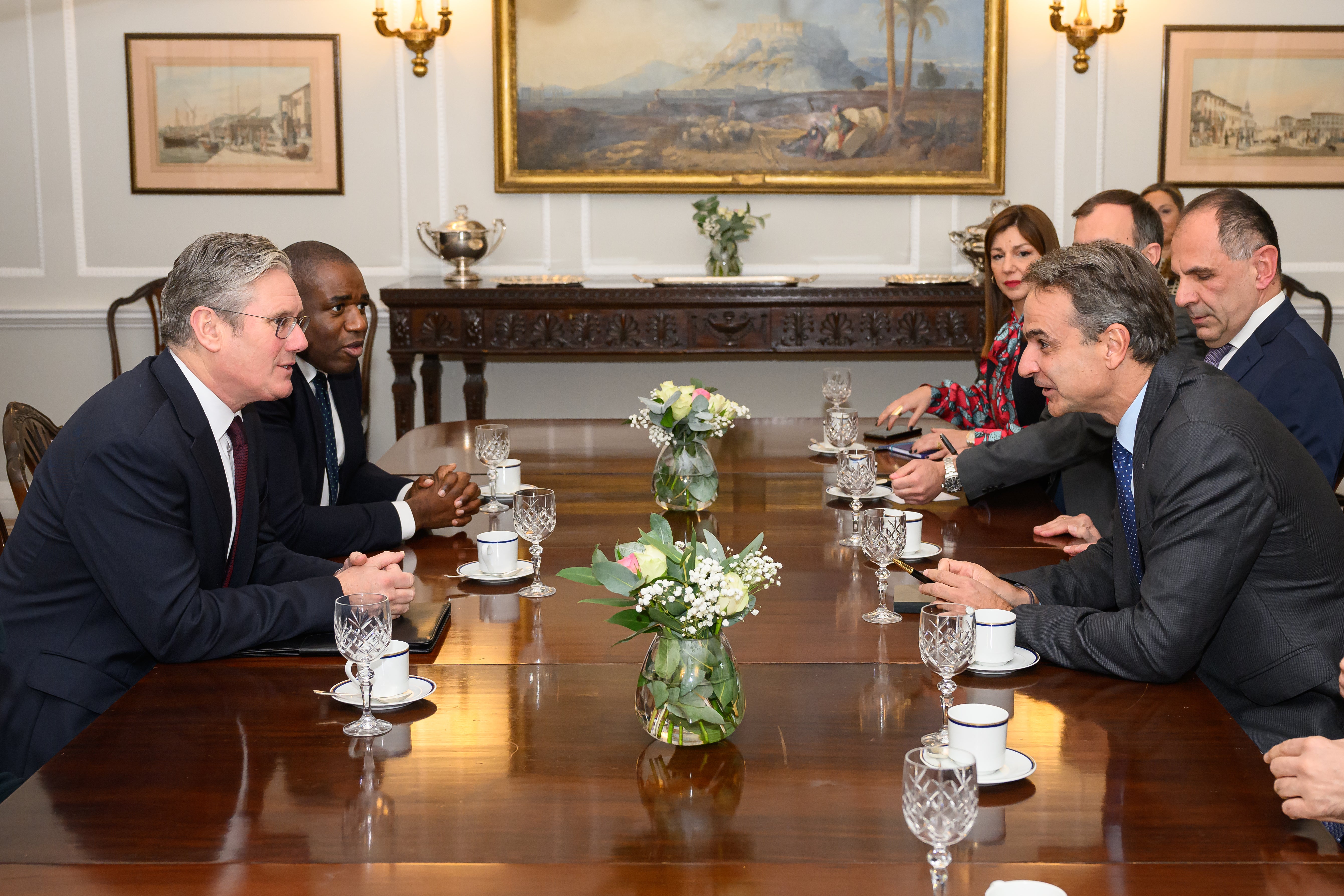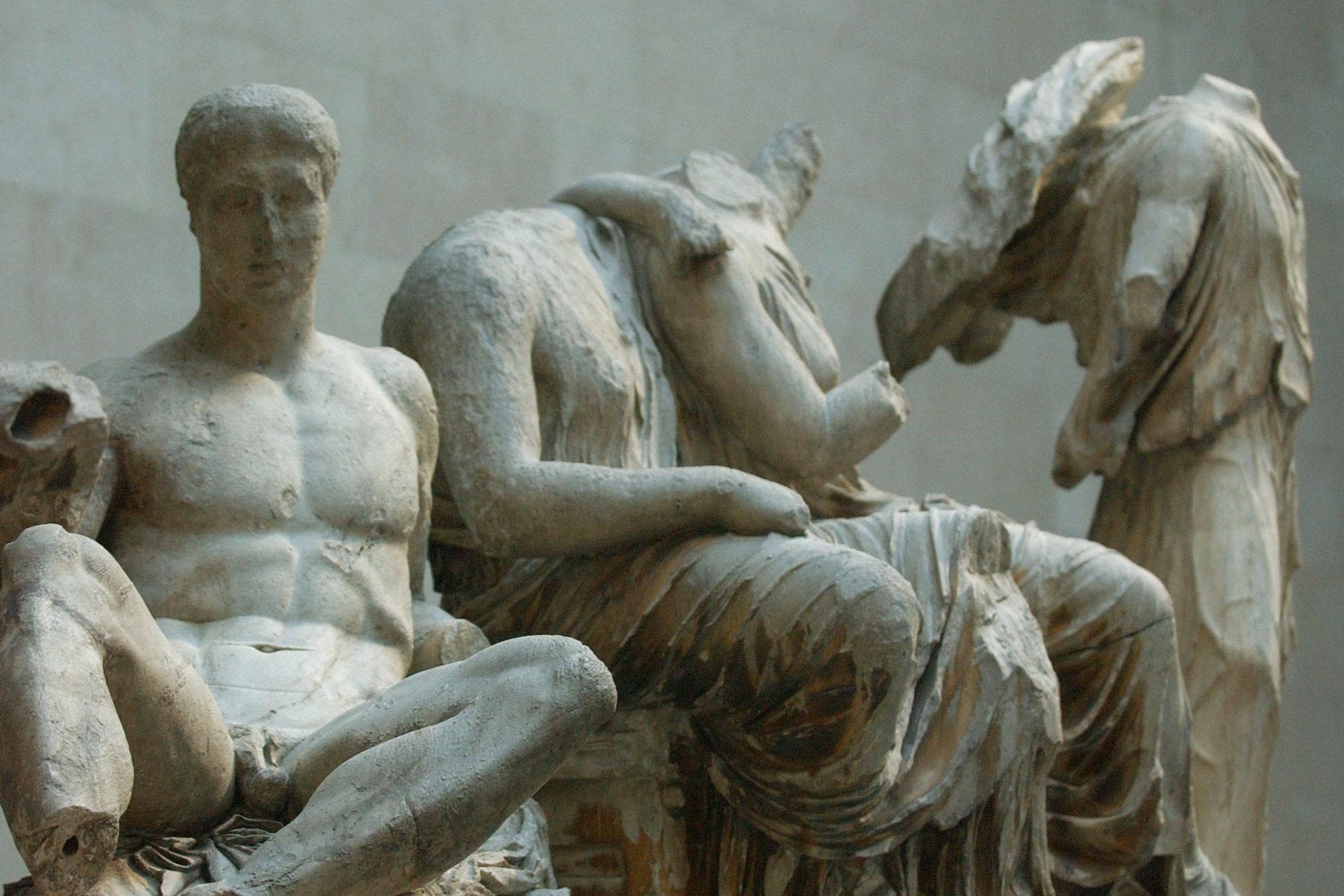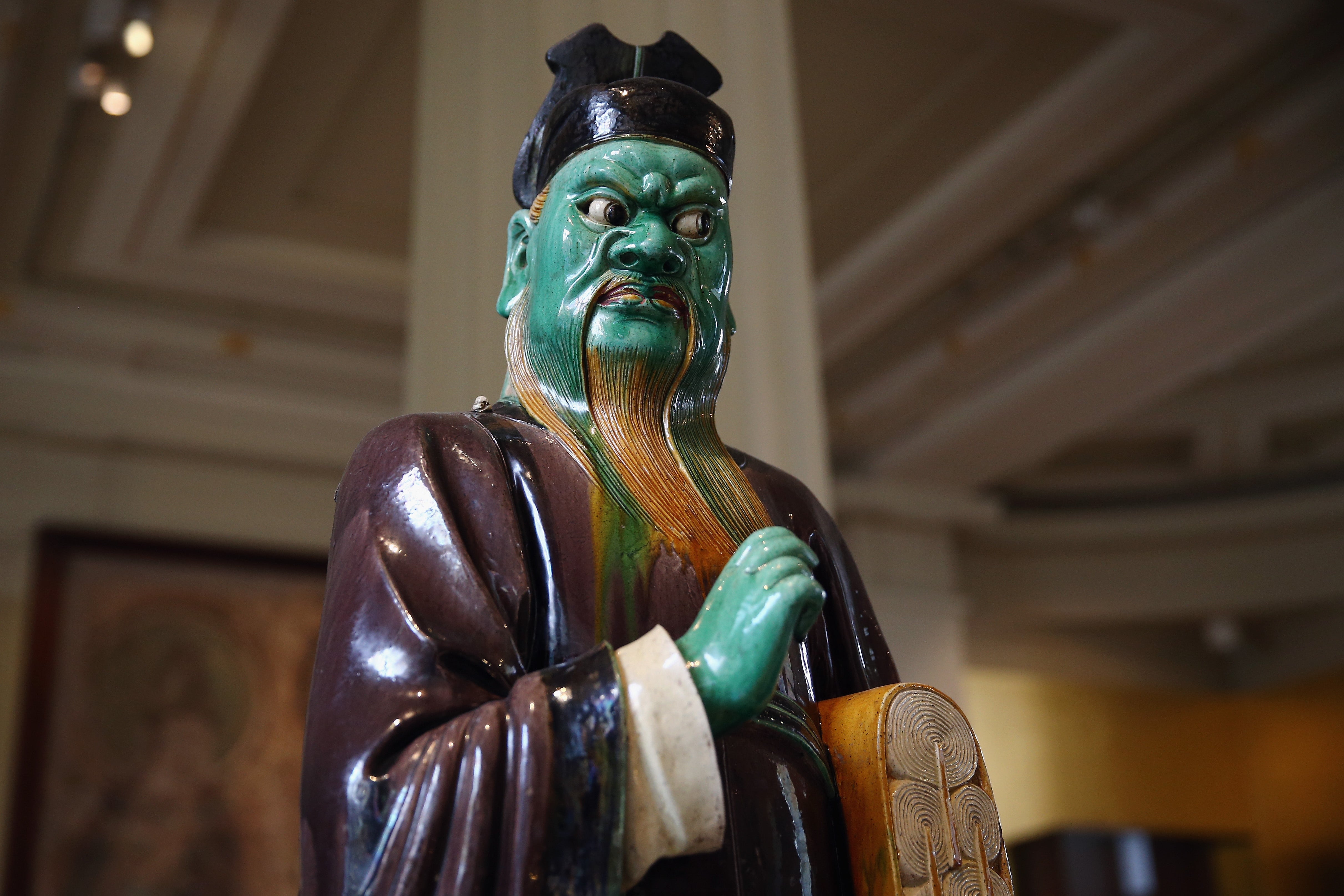
The diplomatic disagreement between Britain and Greece over the ownership of the Elgin Marbles has been brought into the spotlight once again as Sir Keir Starmer welcomes Greek PM Kyriakos Mitsotakis to Downing Street.
Mr Mitsotakis’s visit comes after he reportedly held private talks with the British Museum – which houses the Ancient Greek sculptures – about the prospect of their return.
Three private talks with the museum’s chair George Osborne, a former Conservative chancellor, are understood to have taken place this year.
It is thought that Sir Keir is more open to the idea of repatriating the artefacts to their ancestral homeland. However, he has ruled out discussing the matter with Mr Mitsotakis at his first UK visit since Labour came to power.

A spokesperson for Sir Keir said: “It’s not going to be on the prime minister’s agenda. His focus will be on support for Ukraine and the urgent need for a ceasefire in Gaza.
“Our position on the Elgin Marbles has not changed.
“It remains a matter for the British Museum, and the government has no plans to change the law to permit a permanent move of the Parthenon Sculptures.”
It was reported there was no mention of the Elgin Marbles at the top of a meeting between the two leaders on Tuesday morning.
Mr Mitsotakis’s visit marks the first since his spat with Rishi Sunak over the Marbles last year. The then-prime minister cancelled a planned meeting with the Greek politician at the last minute, with a spokesperson the plans had become “impossible” due to commentary around the artefacts.
Speaking to the BBC at the time, Mr Mitsotakis compared the marbles – also known as the Parthenon Sculptures and stored at the British Museum since the early 19th century – to Leonardo Da Vinci’s Mona Lisa, saying Britain retaining them was akin to carving the famous Renaissance portrait in half and keeping part of it in London and the other in the Louvre in Paris.
The British Museum has regularly faced criticism in recent decades over its right to hold onto the treasures of antiquity it houses, with some believing many of the relics in its collection were effectively “looted” during the colonial heyday of the British Empire and ought to be returned to their countries of origin out of respect for the civilisations that created them.
But the institution makes no secret of the debate surrounding the artefacts within its walls and lists “contested objects” on its website, explaining the historical circumstances of their acquisition and the current state of the often highly sensitive discussions surrounding their retention.
Here’s everything you need to know about its most disputed artefacts:
The Elgin Marbles (Parthenon Sculptures)

The Elgin Marbles, or Parthenon Sculptures, come from the temple of Athena on the Acropolis in Athens, Greece – and continue to represent one of the longest-running controversies concerning the British Museum’s collection.
The museum holds 15 metopes, 17 pedimental figures and a 247-foot section of decorative frieze, all of which are believed to have been crafted between 447 and 432 BC.
They were removed by Lord Elgin, British ambassador to the Ottoman Empire – still governing Greece in the early 19th century – between 1801 and 1805 and were subsequently shipped to Britain. His actions were investigated by a parliamentary select committee in 1816, which ruled that he had committed no wrong but consigned the antiquities to the museum in the best interests of their conservation.
The Greek government first requested they be returned in 1983 and discussions have taken place ever since without resolution. Human rights lawyer Geoffrey Robertson KC accused the museum of being among the “world’s largest receivers of stolen property” in 2019 over its failure to give back the sculptures “and other pilfered cultural property”.
The British Museum states it “takes its commitment to be a world museum seriously”, adding: “The collection is a unique resource to explore the richness, diversity and complexity of all human history, our shared humanity.
“The Parthenon Sculptures are an integral part of that story and a vital element in this interconnected world collection, particularly in the way in which they convey the influences between Egyptian, Persian, Greek and Roman cultures.
“We share this collection with the widest possible public, lending objects all over the world and making images and information on over four million objects from the collection available online.”
A British Museum spokesperson added in a statement to The Independent: “Discussions with Greece about a Parthenon Partnership are ongoing and constructive.
“We believe that this kind of long-term partnership would strike the right balance between sharing our greatest objects with audiences around the world, and maintaining the integrity of the incredible collection we hold at the museum.”
Chinese cultural relics

Another recent appeal for the museum to return items came from China’s state-run newspaper The Global Times, which used the visit of former foreign secretary James Cleverly to Beijing in August 2023 to publish an editorial demanding that the institution give back all items “acquired through improper channels to China free of charge”.
It referred to Britain’s refusal to return artefacts to other countries and accused the museum in particular of ”adopting a resistant, protracted and perfunctory attitude”.
The British Museum houses the biggest collection of Chinese relics anywhere in the West – at least 23,000 objects – ranging from paintings that date back to the Tang dynasty (618 to 907 AD) to bronze vessels from the dawn of China’s civilisation.
Of these, The Global Times reported about 2,000 are currently on display and cited a number of examples it regarded as particularly significant. These included “The Admonitions of the Instructress to the Court Ladies” by Gu Kaizhi, which the museum describes as a “masterpiece” and “a milestone in Chinese painting history” dating from between 400 and 700 AD.
Other items cited include Liao tri-colored Luohan statues; ritual bronzes from the Shang and Zhou dynasties and stone Buddhist sutra scrolls from the Wei and Jin dynasties.
A spokesperson for the British Museum told The Independent at the time: “We understand and recognise the significance of the issues surrounding objects from other countries, and work with communities, colleagues and museums across the globe to share the collection as widely as possible.
“There has been no request for the return of any objects in the collection by the Chinese government.”
The Rosetta Stone

Egypt’s former antiquities minister Dr Zahi Hawass launched a petition in November 2022 calling for the museum to return the Rosetta Stone on the 200th anniversary of its hieroglyphics being deciphered. That breakthrough greatly enhanced the world’s understanding of the wonders of Ancient Egypt.
“It is the time Egyptian identity comes back home. We are not asking the British Museum to return the 100,000 Egyptian pieces they have, we just ask them to return one item,” Dr Hawass said.
The stone was discovered by French soldiers in the northern town of Rashid in 1799 during Napoleon Bonaparte’s military occupation of the country but passed into British hands after the general’s forces were routed in 1801.
Dr Hawass said he hoped to see the stone, which he described as “an icon of Egyptian identity”, displayed in the new Grand Egyptian Museum in Giza.
He is also pursuing the return of the Zodiac of Dendera from the Louvre and the Nefertiti bust from the Neues Museum in Berlin, although he is still some way short of the 1m signatures sought to endorse his appeal for the Stone’s repatriation.
A spokesperson for the British Museum told The Independent at the time: “We have received no formal request from the Egyptian government to repatriate the Rosetta Stone.
“The Rosetta stone is available to all interested audiences, whether in the galleries or via appointment to support academic research.”
The Benin Bronzes

The museum houses over 900 elaborately decorated brass and bronze sculptures and plaques from the West African Kingdom of Benin dating as far back as the 16th century. Commemorative heads, animals, human figures and royal regalia originally crafted by specialist guilds are among the collection.
Benin City is now the capital of the state of Edo in southern Nigeria but was part of the British Empire from 1897 to 1960. Many of its relics ended up in the hands of British collectors during this period, including the likes of Harry Beasley, William Oldman and Sir Henry Wellcome, who subsequently donated their items to the British Museum in 1944, 1949 and 1954 respectively.
The institution reports that it received a written request for the return of “Nigerian antiquities” from Nigeria’s Federal Ministry of Information and Culture in October 2021 and that representatives of the Benin Royal Palace have made a number of public statements calling for their return.
The museum states it has been in discussions over the issue for several years, with Mr Fisher visiting Nigeria in August 2018, and enjoys “positive relationships” with the royal palace in Benin City, the Nigerian National Commission for Museums and Monuments (NNCMM) and the Benin Dialogue Group.
It says it remains “committed to thorough and open investigation of Benin collection histories, and engagement with wider contemporary dialogues within which these collections are positioned”.
However, the theft of 2,000 pieces from the museum’s Towneley collection of Graeco-Roman artefacts that emerged last year has heightened calls for the return of the Benin Bronzes, with Abba Isa Tijani, the NNCMM’s director telling Sky News in August 2023: “It’s shocking to hear that the countries and museums that have been telling us that the Benin Bronzes would not be secure in Nigeria have thefts happening there.”
The Maqdala collection
The museum holds 80 objects from the reign of Ethiopia’s Emperor Tewodros II in the mid-19th century, including ornate ceremonial crosses, chalices, weapons, textiles, jewellery and archaeological material.
Tewodros succeeded to the throne of Maqdala, now known as Amba Mariam, in 1855. Seven years later, he called on the British to help train his military in order to shore up his territorial claims in East Africa but the appeal was rejected. Enraged, Tewodros reacted by imprisoning the British consul and taking hostages, including Christian missionaries.
Britain responded by dispatching troops under Sir Robert Napier to mount a rescue operation and lay siege to Maqdala, leading to the death of Tewodros in 1868 and the pillaging of his fortress by soldiers, much of the spoils subsequently picked up at auction by British Museum employee Richard Rivington Holmes and entering the archives.
Delegates from Ethiopia have often visited Bloomsbury in recent years, including culture minister Hirut Kassaw in March 2019, to request the return of its sacred objects and the matter remains under discussion.
“The Museum’s sustained long-term ambition relating to the tabots is to lend them to an Ethiopian Orthodox Church in Great Britain where they can be cared for by the clergy within their traditions,” added the British Museum.
The Moai

Two moai are currently held at the museum. These are monolithic ancestral heads originating from Rapa Nui in the South Pacific, better known as Easter Island in English.
The first moai, Hoa Hakananai’a, is carved from basalt and has been dated to 1000-1200 while the second, Moai Hava, was made from volcanic tuff between 1100 and 1600.
They were removed from the island by Commodore Richard Powell of HMS Topaze in 1868, who returned to England with them a year later. They were subsequently gifted by the admiralty to Queen Victoria, who in turn donated them to the museum.
Rapa Nui requested their return in a letter of July 2018 and a delegation of representatives arrived the following November.
A reciprocal visit was made in August 2019 and the museum is now in the process of “developing a long-term relationship with the community of Rapa Nui”.
Early Australian shield
The British Museum loaned a tribal warrior’s shield – carved from red mangrove wood and thought to date back to the New South Wales of the late 1700s – to the National Museum of Australia in Canberra for an exhibition in 2015/16.
There, it was seen by Aboriginal man Rodney Kelly, who appealed for its return on behalf of his ancestors. He has since visited London on several occasions to meet with the curators, most recently in 2019, and has asked for further research to be carried out into the shield’s history.
It is not clear exactly how the museum obtained it in the first place, although it is believed to have been shipped back from Sydney between 1790 and 1815, possibly by affiliate Joseph Banks, although this is not certain. The museum said it would “consider lending the shield again”.
Objects of uncertain provenance 1933-45
One of the most tricky and sensitive areas for the British Museum is establishing whether any of the objects donated to it since the Second World War were in fact stolen, looted or otherwise taken by the Third Reich prior to or during the conflict.
In cases where it has become clear that “an object was forcibly obtained by the Nazis, every effort has been made to ascertain that it was correctly restituted at the end of World War II and that the Museum’s acquisition was made with good title”, the museum explains.
It settled a number of claims related to artworks, antique clocks and watches and valuable porcelain between 2006 and 2014.
Human remains
The British Museum reports it has more than 6,000 human remains in its collection, which it says are “managed in a way that protects the collection for the benefit of present and future generations”.
It says it has received two requests for repatriation since the Human Tissue Act 2004 came into force in 2005: the first in July that year for two cremation ash bundles from the Tasmanian Aboriginal Centre and another in May 2011 for two skulls from a Torres Strait Islander organisation - in cooperation with the Australian government in both instances.
Following a review, the ash was ultimately returned but the skulls were retained after the trustees ruled there was insufficient evidence to support the claim on them.
The museum also lists six prior requests between 1995 and 2004, four of which had been made by the Tasmanian Aboriginal Centre for the same material.







